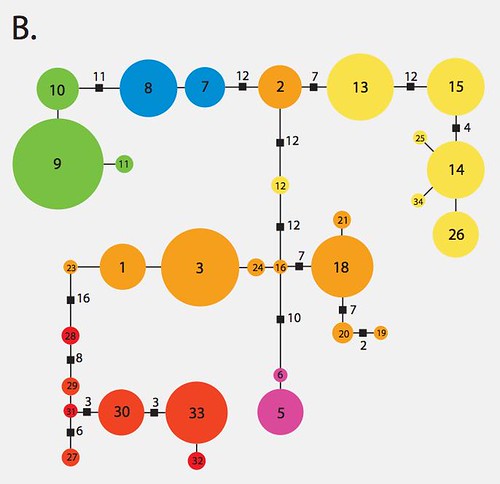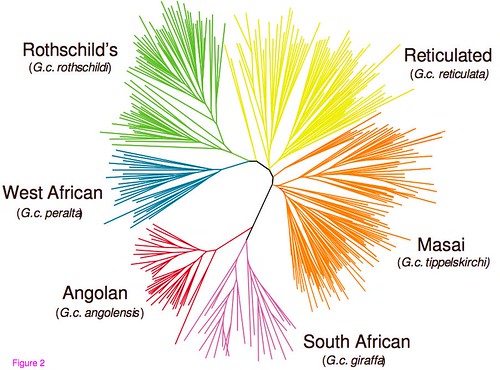tags: researchblogging.org, giraffe species, Giraffa camelopardalis, speciation, evolution, conservation, molecular phylogeny
West African giraffe, currently Giraffa camelopardalis peralta.
Image: Wikipedia (Creative Commons) [larger view]
How many species of giraffes are there? Well, it may surprise you to learn this, but some people have actually thought about this throughout the decades, and they decided that there is only one species, Giraffa camelopardalis. However, a paper published today in BMC Biology convincingly demonstrates that giraffes are actually comprised of at least six, and possibly as many as eleven separate species instead of just one, as originally thought.
According to findings published by a research team led by David Brown, a geneticist at University of California Los Angeles (UCLA), these giraffe species live in different regions of sub-saharan Africa and show distinct and easily visible differences in their patched markings that are so different that these populations had previously been classified into separate subspecies.
However, mitochondrial DNA (mtDNA) and nuclear microsatellite loci DNA analyses of six of the nine subspecies reveal that these populations are more distinct than previously thought; for example, the reticulated giraffe (Currently: Giraffa camelopardalis reticulata) in North Kenya, which has reddish round spots; and the Masai giraffe (Currently: Giraffa camelopardalis tippelskirchi) in South Kenya -- genetically separated from each other between 0.5 and 1.5 million years ago (Figure 1A, below);
Approximate geographic ranges, pelage patterns, and phylogenetic relationships between giraffe subspecies based on mtDNA sequences. Colored dots on the map represent sampling localities. The phylogenetic tree is a maximum-likelihood phylogram based on 1,707 base pairs of mtDNA sequence (1,143 nt of cytochrome b, 429 nt control region and 135 nt of tRNA) from 266 giraffes. Asterisks along branches correspond to node-support values of > 90% bootstrap support. Stars at branch tips identify paraphyletic haplotypes found in Masai and reticulated giraffes. [larger].
KEY: red; Angolan giraffe, G. c. angolensis; blue; West African giraffe, G. c. peralta; green, Rothschild's giraffe, G. c. rothschildi; yellow, reticulated giraffe, G. c. reticulata; orange, Masai giraffe, G. c. tippelskirchi; pink, South African giraffe, G. c. giraffa.
"Using molecular techniques we found that giraffes can be classified into six groups that are reproductively isolated and not interbreeding," in the wild, said Brown. A biological species is defined as a group of organisms capable of interbreeding and producing fertile offspring. However, because this is a very imprecise definition, there are other, more precise, species concepts. With the advent of modern technologies, more precise definitions have been formulated based on similarities in DNA, morphology or song, or some combination of these.
This amount of genetic differentiation is unique in large-bodied and highly mobile African mammals, whose different populations are likely to meet in the wild. This implies that there are environmental and behavioral mechanisms that limit gene flow between these populations.
"There are no rivers or forests to prevent breeding, but some evolutionary process is keeping the two groups reproductively separated," Brown pointed out.
These evolutionary processes likely include sexual selection as well as behavioral isolation, particularly distinct breeding seasons that could result in offspring that are born in the inappropriate season and demonstrating reduced fitness. Additionally, there could be differences in local habitats that each species has adapted to which prevents hybridization.
But where did all these giraffe species originally come from? To determine the likely geographic origin of giraffes, the team analyzed the mtDNA diversity in all giraffes sampled and found that Masai and reticulated giraffes were most centrally placed using the minimum-spanning DNA network, suggesting that East Africa could represent the geographic origin for giraffes (Figure 1B, below);
Minimum-spanning network of control region haplotypes using the molecular-variance parsimony algorithm, where circles represent haplotypes, numbers within them correspond to haplotype designations, and circle sizes are proportional to the haplotype's frequency in the population. Branches represent a single nucleotide change and black squares represent multiple changes (indicated by adjacent numbers). Colors are coded as in Figure 1A (above). [larger].
These DNA data are consistent with the fact that the earliest fossil remains of Giraffa camelopardalis have been found in East Africa.
How are these giraffe species genetically related to each other? To investigate the relationships between the different populations of giraffes sampled, the researchers used a neighbor-joining analysis of shared genetic differences. This analysis revealed that giraffe genotypes were strongly clustered into subspecific groups (Figure 2, below);
Neighbor-joining network of allele-sharing distances (Ds) based on 14 microsatellite
loci typed in 381 giraffes. [larger].
These data suggest that the divergence times between the seven giraffe clades ranged from 0.13-0.37 million years (MY) between Masai and South African clades, to 0.54-1.62 MY between the southern clade (Masai, Angolan and South African giraffes) and the northern clade (West African, Rothschild's and reticulated giraffes). Divergence values for the northern giraffe grouping were intermediate, with West African and Rothschild's giraffes diverging about 0.16-0.46 MY ago, with these two species splitting from reticulated giraffes about 0.18-0.54 MY ago. These dates argue for a mid- to late- Pleistocene radiation of giraffes. This was a time of intense climatic change in sub-Saharan Africa.
Taken together, these data have important implications for conservation planning because different species of giraffes present different conservation priorities and challenges.
"Lumping all giraffes into one species obscures the reality that some kinds of giraffe are on the brink," said Brown. "Some of these populations number only a few hundred individuals and need immediate protection."
Sadly, there has been a 30% drop in the giraffe population, with total numbers less than 100,000, during the previous decade. By providing giraffe subspecies with full species status, this will help conservation organizations make plans to preserve the most threatened populations. These (sub)species include the Nigerian giraffe (Currently: Giraffa camelopardalis peralta), which numbers only 160 individuals, and the Rothschild giraffe (Currently: Giraffa camelopardalis rothschildi), which numbers only several hundred.
The International Giraffe Working Group (IGWG) is currently reviewing these animals' status and their decision will influence the status of giraffes on the IUCN Red List of threatened and endangered species.
Sources
Brown, D.M., Brenneman, R.A., Koepfli, K., Pollinger, J.P., Milá, B., Georgiadis, N.J., Louis, E.E., Grether, G.F., Jacobs, D.K., Wayne, R.K. (2007). Extensive population genetic structure in the giraffe. BMC Biology, 5(1), 57. DOI: 10.1186/1741-7007-5-57 [free PDF].
Luciano B. Beheregaray and Adalgisa Caccone. MiniReview: Cryptic biodiversity in a changing world. (2007) Journal of Biology 6:9 | doi:10.1186/jbiol60 [free PDF]. (further reading).
BBCNews (quotes).
- Log in to post comments





So... in chart A, could you fix it so that there is a marker that represents when The Flood happened? I'm doing a painting, and I need to know whether I need 2, 4, or more giraffe heads sticking up over the other kinds.
*ducks, runs*
Nice post! I'm not even going to bother covering this one!
So did all 12 Giraffe each take turns sticking their heads out of the single window in the ark?
i am not sure if the eggnog has made you guys more humorous, or if it has made me think you are more humorous, but a few of my sciblings and i are amused by your comments so we are having a contest that we'd love you to participate in.
Hey, anon - at *least* you need 14 heads. Giraffes are clean, so there have to be *seven* pairs!
Oh, I see: "one pair of unclean, seven pairs of clean". Yummy giraffe-burgers! I can has giraffeburger?
I'm really pleased to see that this work is finally out: I sort of had a preemptive discussion of it here and have enjoyed mentioning it every time I've had the opportunity to talk or write about living giraffes.
Anybody knows for sure why they've got their long necks?
How is species being defined?
Is it not interbreeding or not inter-fertile?
If they don't interbreed I guess they'll eventually become not inter-fertile but has that happened yet?
Microevilution on Ye Arke. There was only one window so not too much light or air. There were lots of (then short-necked) giraffes and other clean beasties. All suffering. It smelled really bad. Well, the giraffes had a pow-wow and hit on a cunning plan: Evilve longer necks! Then each could stick its head out into all that lovely refreshing rain. So they microelonged their necks.
Rumour is they had a bit of problem leaving Ye Arke after it crashed into that inconveniently placed mountain. The hatch wasn't built for such a tall critter. Ye Arke had to be dismantled to get them out. That's why no trace of it exists today.
Nice post!
WTF??? why is everyone acting so dumb, instead of talking about this scientific research, we are making fun of creationists? What im wondering is how the heck did they find out how longago the divergence times were? Guess or research?
The fine article went on and on and towards the end they finally mention a "Nigerian Giraffe". So there's another? Wow!
Nobody is acting dumb here, Sinn. Some, in fact, are, and all others enjoy reading about them coming out as such and that's why it all reads funny ...... Maybe somebody sends the article and the blog to the Warden of the creationist museum just outside of Cincinnati, Ohio (unfortunately, it's actually in Northern Kentucky). Just wait how much more fun this blog will get once he joins in .....
The article itself is awesome - fine work, from the original idea to safari expertise and animal husbandry (they had to roam in Africa, escape Simba and take the samples!) to molecular evolutionary analysis!
Yours,
Another E- guy ... :0)
Research. Read up on molecular dating = molecular divergence date estimation.
These are two of about 25 species concepts...
BTW, wolves and coyotes interbreed in the wild. (Even though wolves eat coyotes.) How many species? One? Two? Three (the hybrids are common enough in some places to be called red wolves)? Depends on the species concept.
I already knew that species was a fuzzy concept, but for lage mammals a lot of the fuzziness goes away.
I was just wondering what definition the researchers used; after re-reading it appears not-interbreeding rather than not-interfertile was used along with the patterns on the skin as a strong initial visual guide.
Few things in biology are ever "known for sure". Last I heard, the leading theory was runaway sexual selection with a bit of serendipitous benefit afterwards (males start battling by whacking each other sideways, long necks win, the female phenotype gets dragged along and voom). Sexual selection is responsible for many of the most astonishingly fast, astonishingly radical and astonishingly silly phenotypic changes in nature.
the problem is easy to see . these guys are racists. i mean two giraffs meet on a dark night in the park and nothing happens? c,mon. "babe, y,got ,like round spots, that is so declasse!" i,m trying to imagine the white sheets and forget about the pointed hood! stunning! racism in the natural world.
Please can you tell me why a small herd of giraffe in the Ithala Game Reserve, Ntshondwe Camp, Northern KwaZulu Natal South Africa should have swollen hocks and badly deformed hooves. I can email you a photo of this if you would like. The reserve is run by KZN Wildlife, previously the Natal Parks Board. I have queried this with them but did not get an answer. I am not sure how to forward the photo to you, i.e. what email address.
Many thanks
Carolyn